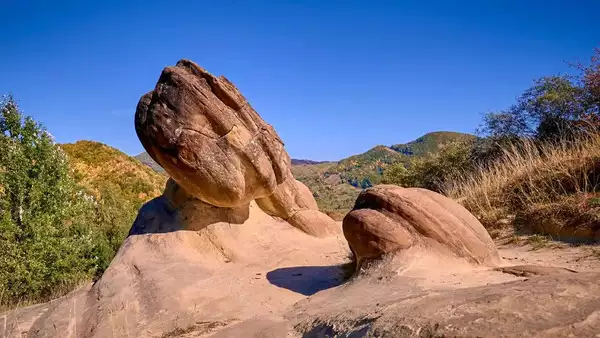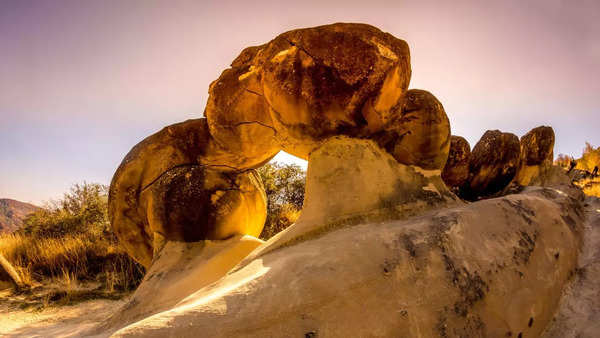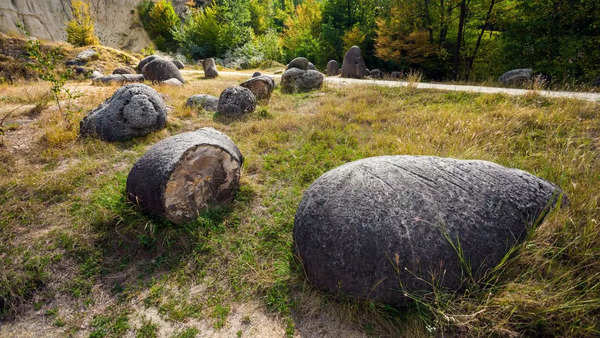Trending
Mysterious living stones that grow, move, and reproduce
The Trovant stones of Romania, found in Costești, are remarkable for their ability to grow, move, and reproduce. Formed millions of years ago, these unique stones expand after rainfall due to a chemical reaction with minerals in the water. Over time, small stones called “microtrovants” form on the surface of larger ones, eventually breaking off to grow independently. These mysterious "living stones" continue to fascinate scientists and tourists alike, with research ongoing to uncover their secrets.

The Trovant rocks of Romania are ancient rocks which are growing till present day. Source: Canva
Trovants are not your typical rocks. They range in size from small pebbles to large boulders, some reaching up to 15 feet (4.5 meters) in height.
These stones are composed mainly of a hard stone core surrounded by sand that forms their outer shell. What sets them apart is their ability to grow and change shape over time, a phenomenon that has led locals to describe them as “living stones.”

Their ability to grow and change shape over time has given them the name of "living rocks." Source: Canva
The growth of Trovants is linked to their unique composition and the environmental conditions in which they are found. When it rains, the minerals in the rainwater interact with the chemicals already present in the stones. This interaction creates a pressure reaction inside the stones, causing them to expand and grow. The growth rate is slow, with an estimated deposition rate of about 1.5 to 2 inches (4 to 5 centimeters) every 1,000 years.
The ability of Trovants to “reproduce” is another fascinating aspect. After heavy rains, smaller stones, known as “microtrovants,” can form on the surface of larger ones. These smaller stones eventually break off and continue to grow independently. This process has led to the belief that Trovants can give birth to new stones, adding to their mystique.

These rocks also reproduce and the reproduced rocks are known as microtrovants. They grow right on top of the original trovants. Source: Canva
The origins of Trovants date back millions of years. Scientists believe that these stones were formed during the Middle Miocene sub-epoch, around 5.3 million years ago. The area where they are found was once an
ancient marine environment, which explains the presence of bivalve and gastropod fossils within the stones. Earthquakes and other geological processes over the millennia have shaped these stones into their current forms.
The Trovant stones have become a significant tourist attraction in Romania, drawing visitors from around the world. The Costești Museum, established to protect and showcase these unique geological formations, offers guided tours and educational programs to help visitors understand the science behind the stones. The museum also emphasizes the importance of preserving these natural wonders for future generations.

The preservation of Trovant rocks is a task which conservationists take seriously. Source: Canva
Despite their popularity, Trovants remain shrouded in mystery. Researchers continue to study these stones to uncover more about their formation and growth processes. The Geological Institute of Romania, led by experts like Dr. Mircea Ticleanu, has been at the forefront of this research, providing valuable insights into the nature of Trovants.
The Trovant stones of Romania are a remarkable example of the wonders of nature. Their ability to grow, move, and reproduce challenges our understanding of what it means to be a rock. As scientists continue to study these fascinating stones, we may yet uncover more secrets about their origins and behavior.
The Trovant stones of Romania remain a captivating natural phenomenon, intriguing scientists and visitors alike with their mysterious ability to grow, change shape, and seemingly reproduce. As research continues to uncover the secrets behind these "living stones," they stand as a unique reminder of nature's wonders and the complexity of Earth's geological history. Fascinating isn't it?
Did you like this article? Please let us know in the comments below!
Medithon-Growing-Heart _Webinar 1
End of Article
FOLLOW US ON SOCIAL MEDIA









